Datura is doing great this spring!
May 10, 2022

Some kind of bug is eating the leaves. Datura is psychoactive and poisonous to mammals so we wonder if the bugs get high… or dead.
Filed under: Uncategorized | Comments (0)
May 10, 2022

Some kind of bug is eating the leaves. Datura is psychoactive and poisonous to mammals so we wonder if the bugs get high… or dead.
Filed under: Uncategorized | Comments (0)
November 12, 2020
It can be tough to follow Michael Pollen’s. prescription: “Eat food, not too much, mostly plants.” As Lynell has battled cancer her tastes change dramatically and we tend to drift into a brown/white dominated diet. Here are some fast, tasty ways I’ve been adding greens to the menu.
Modified from https://runningonrealfood.com/whole-wheat-fluffy-vegan-pancakes/
Steps
My own invention for busy mornings.
Coat a microwave safe bowl with oil. Cover the bowl with a plate and microwave for 1 minute. Skip this if you are using parsley or just want a chewy breakfast. Whisk your egg and water in the bowl. Cover with a plate and microwave for 2 minutes.
It comes out sort of like a poached omelette. If there is any uncooked egg at the bottom, zap it for another minute.
Don’t bother searching, I made it up! Roasted mashed yams are so yummy, I thought they could handle a nutrient upgrade. This is a very loose recipe…
Steps
Filed under: Uncategorized | Comments (0)
November 7, 2020
I’ve tried a lot of things and would love others to get started so here’s my best advice on pickling equipment. Just to be clear though…
You don’t have to have all this stuff!
You’ll get good results with any old jury rigged system you come up with so long as you use the right amount of salt and keep the food under the brine at all times. Once you get hooked and start doing this a lot (’cause you will!) upgrding your gear will save you time and irritation.

An airlock lid is the easiest way to keep mold and yeast out of your jars so lactobacilli can do their magic. Many are designs from brewing, others are fance, expensive things.
I like Pickle Pipes and similar products. They are cheap, simple, work really well, and last forever. It’s just a silicone rubber insert that works with the canning rings that come with your jars.

Sounds very technical! Most folks use weights like glass or ceramic, placed on top of the food in the jar. They suck. Things shift around and drop down the side of the jar. There are also spring or turnscrew contraptions but they are expensive so I haven’t tried ’em. I tried using a plastic bag with air in it, that’s a big mess.
The best things I’ve found are Occupare Vita “food retainer cups” from Quality Reliable Products. I simply can’t recommend these strongly enough, they work perfectly every time. Their website is clunky and I can’t get just the cups from them directly anymore, only kits. However, if you’re OK with Amazon you can get just the cups there for either wide mouth or regular mouth jars.
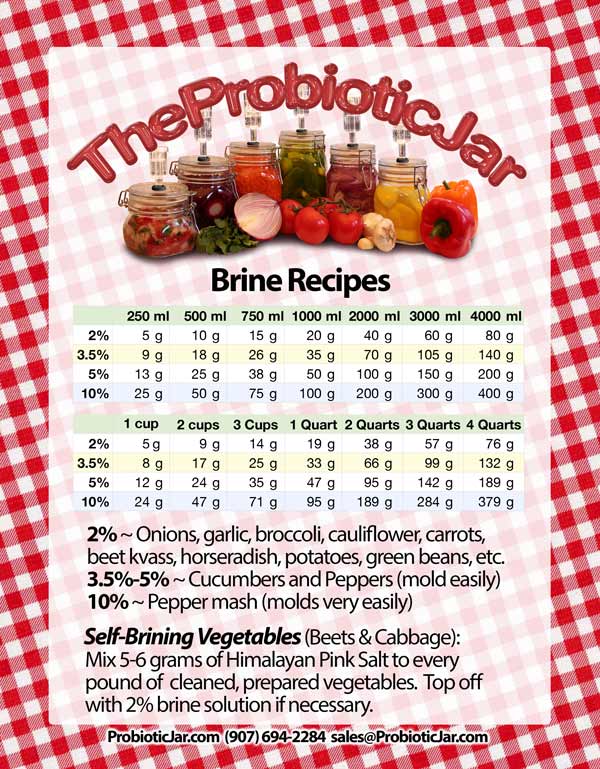
All that really matters is using a salt without iodine. Iodine kills the helpful critters you are lovingly cultivating in your food. Any type will do.
That said, I like sea salt b/c it has minerals.
The most important thing is measure your salt by weight! This is very important for repeatable results and possibly food safety. Different types of salt have different grain sizes. So a tablespoon of kosher salt is not the same amount as a tablespoon of sea salt. If you measure by volume, you really don’t know how salty your brine is. Getting this right is important for finding the flavor you like and to ensure the ferment is safe… though it’s hard to screw that up.
Weigh the food and water you are fermenting in grams. Divide by 100. That’s how many grams of salt you need for 1% salinity. So easy.

Easily replaceable with spoons and such, but I like having this object around. It’s a lovely piece of wood with a pleasing shape. They make it much easier to press the gas out of during primary fermentation. Masontop is a good source but there are plenty of cheaper options.
Filed under: Uncategorized | Comments (0)
November 7, 2020
I have never liked them. 10 years ago we joined a CSA for a weekly box of vegetables and for a while we got some every week. What do do with them? I tried sautéed, au graten, mashed with potatoes, quick vinegar pickles. Blech. Blech. Blech. Blech.
This year we started our CSA box again and sure enough we got some turnips. What to do?
Fortunately I’ve been upping my pickle game for a couple years now so let’s give it another go! Fermented this time.
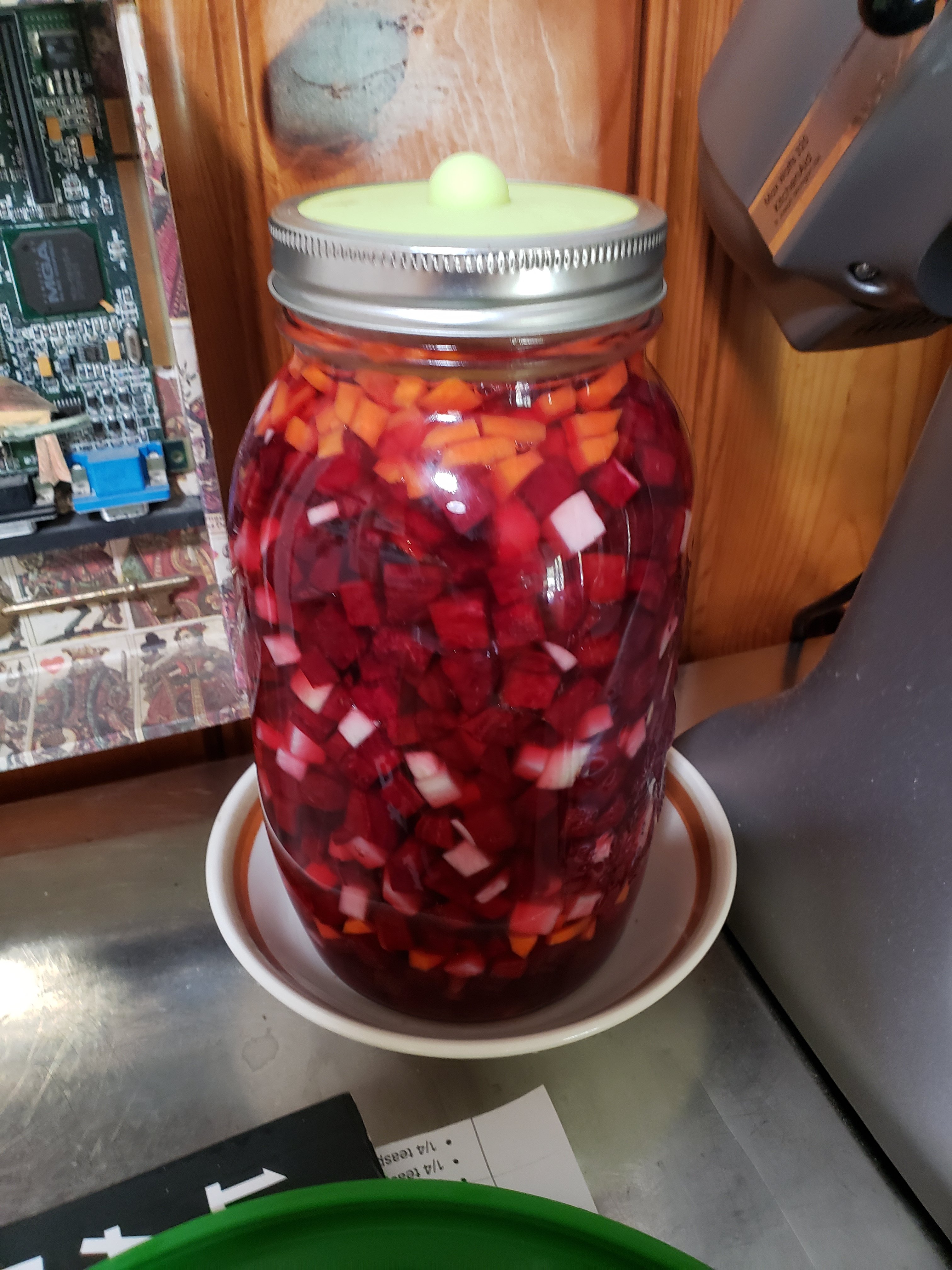
Put all the vedge in a 2qt jar. Leave about 2″ space at the top… top off with carrots or other veggies if needed. Fill with non-chlorinated water. Pour out the water into a bowl. Add the salt to the water and stir until dissolved… I like to use an electric mixer to speed things up.
The contents of my jar weighed 1500g so I used 22g salt for just under 1.5% salinity. Salt by weight is the only sane way to ferment.
Coarsely grind the spices in a coffee grinder. Grinding them is new for me, I want a strong spicy flavor this time. I did 6 seconds in an electric one. Pour this into a cotton tea bag and tie the top tightly shut. Put it in the jar and cover with some vedgetable.
Pout the saltwater in and close it up with your favorite airlock lid. Use pickle weights if you want… but nothing beats these pickle cups.
Put the jar in a dish on the counter because it is going to get bubbly! It will definitely leak some. After the first day, check it a couple times daily and press it down with a spoon or tamper if needed. If too much brine leaks out replace it with 1% saltwater.
Let it ferment for at least a week. Two if you can wait that long! The acids will help soften the food and smooth out the stronger flavors. Start tasting after a week and stop when you like it. Put it in the fridge for up to a month.
Filed under: Uncategorized | Comments (0)
November 6, 2020
It’s the Walmart of the internet, grinding up small businesses and sucking up huge sectors of the economy. My small act of eschewing their marketplace won’t turn the tide… but I’ll feel a whole lot better about every purchase.
I’ll keep updating this post as I find new sources.
Sure OK, use Amazon to search but look at the seller name… often it’s the company that makes the product. Google up their website and buy direct. More of your money will go to them rather than the middleman. Sometimes this is cheaper! Amazon is like any large company/monopoly… once they have a captive customer base they selectively increase prices to squeeze more $$$ out of you.
https://www.ebookwoman.com/ – Local Austin business, sells ebooks via Kobo for a portion of the sale.
If you prefer paper, https://bookshop.org is a newly successful non-profit that has grown 10x during the pandemic and enables local book stores to survive and thrive.
https://www.vitacost.com/ or directly from preferred brands.
Anyone else have a great way to starve the behemoth? Create an account and comment!
Filed under: Uncategorized | Comments (0)
July 16, 2020
I’ve tried a number of variations including traditional bread kvass. This one is my favorite! A tart, fizzy, probiotic beverage with lots of vitamins and minerals. Great over ice on a hot day.
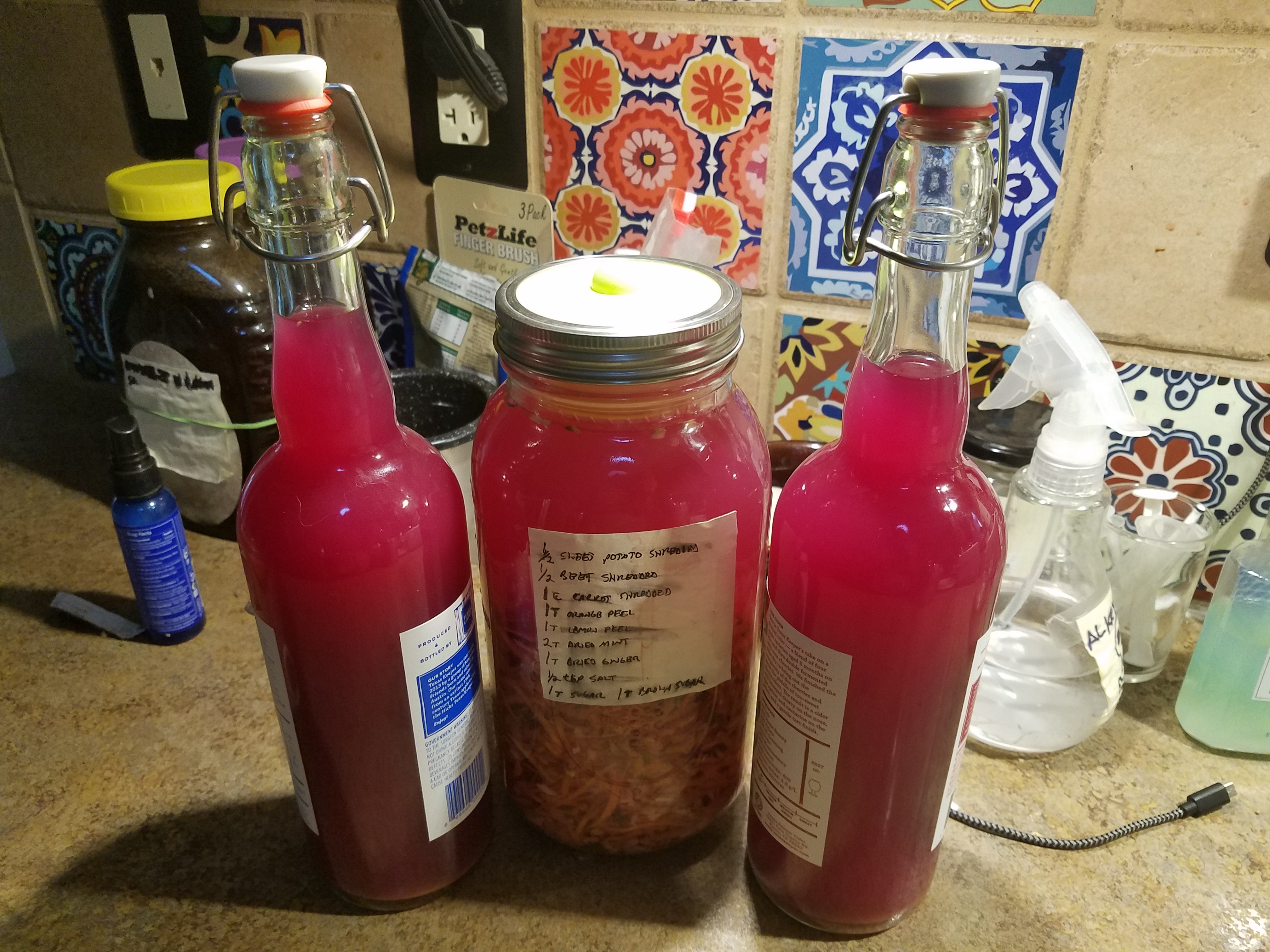
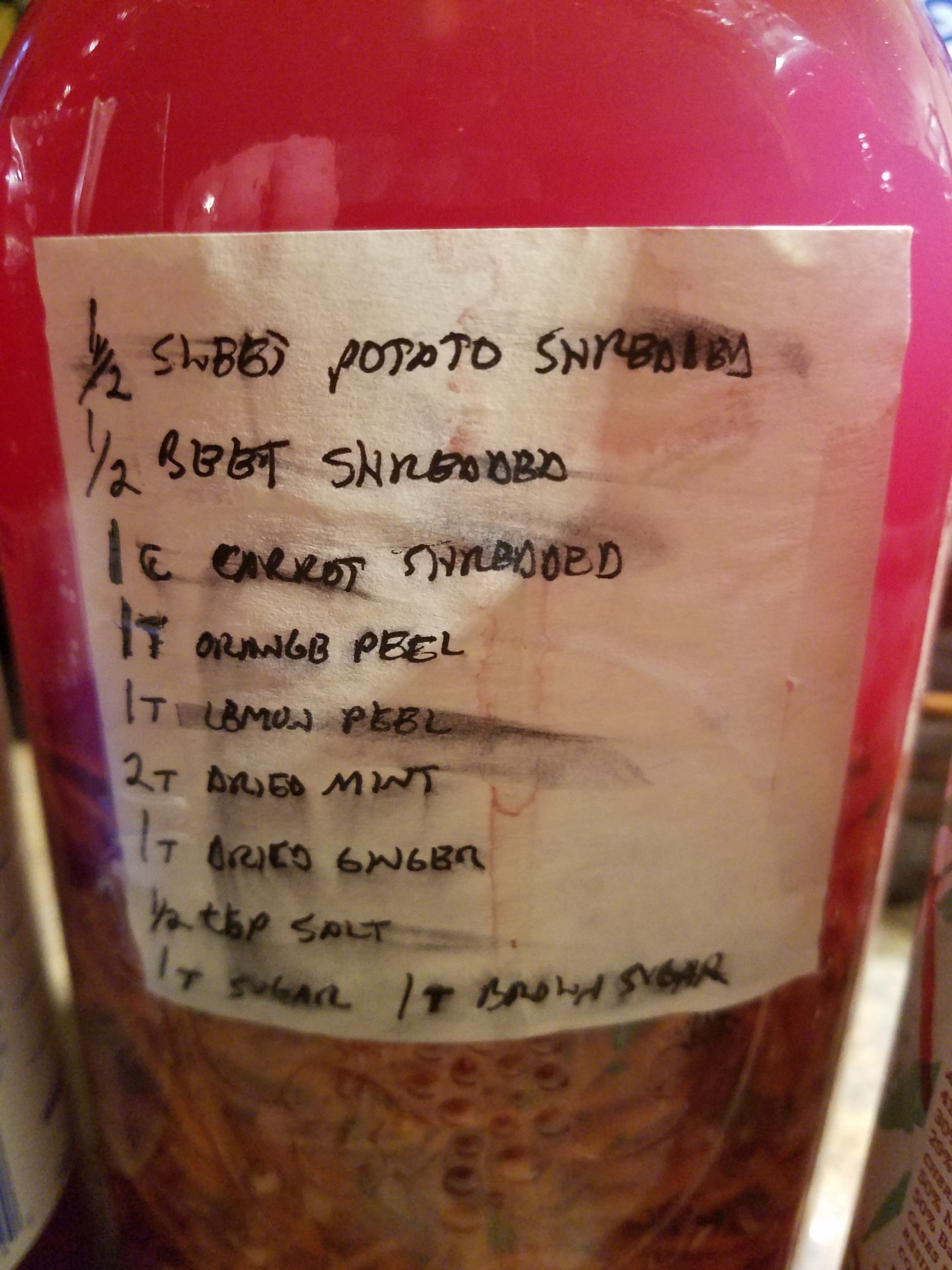
Carrot is the base, it has good natural sugars for the lactobacilli to eat and priduces a bright, sharp taste. The beet is for color, but too much makes it too earthy IMHO. The sweet potato makes it creamy due to starches so you have a foamy head when you pour.
Pour over ice and sweeten to taste. Lovely!
For a second “press”, add 2 Tbsp sugar to the jar and refill with water. It will be milder flavored so don’t dilute it when you bottle. Let this one ferment for longer to extract all the good stuff from the mash.
For bottling use the grolsch style flip tops or plastic soda bottles. Capped beer bottles if you like manual labor. Other bottles that aren’t made for pressure might burst.
If you are missing some ingredients just try it anyway! All you really need are root vegetables and flavor components. For me the mint is a must and I would increase the ginger if I had a surplus.
Filed under: Uncategorized | Comments (0)
March 8, 2020
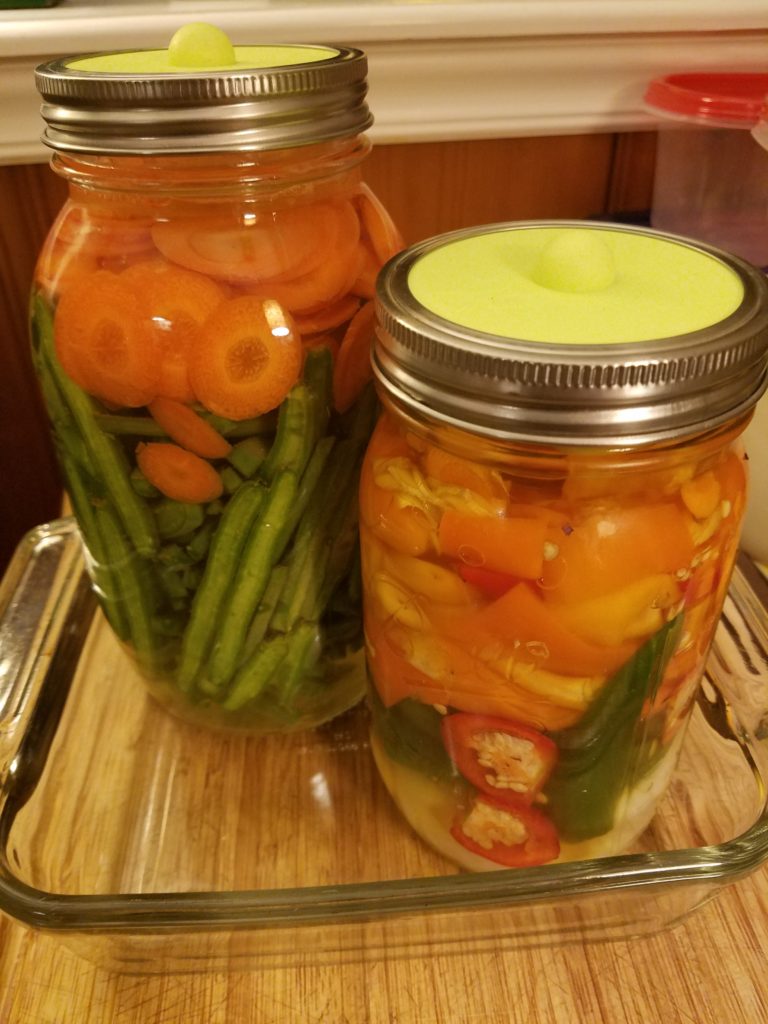
My first adventure in foraging!
The nopales are an experiment. It’s the same paddle cactus that you see everywhere that also makes prickly pear fruit aka tuna (spanish). I’ve also seen a local brand of moonshine made out of paddle pulp, sort of like tequila is made of agave. Projects for another day!
I also grilled a couple paddles, commonly known as green steak. The recipes I read said not to peel the waxy skin off… but ugh! That’s bullshit. They have a great tangy flavor, quite interesting, but the waxy skin leaves a woody mash in your mouth. I’m gonna try grilling again with peeled ones.
Because of this, I’m worried that the skin will be a problem for the fermented pickle strips. When I’ve bought them in a jar they didn’t seem to have that. Maybe the lactic acid will break it down?
Fingers crossed!
Filed under: Uncategorized | Comments (2)
January 21, 2020
It’s spring, the time of rejuvenation and resolutions. I’m slowly rallying myself to restart various food related hobbies. Yogurt, cold brew, sauerkraut… spring pickles! Hopefully it’s not jinxing things to share the recipes before I see how they turn out.
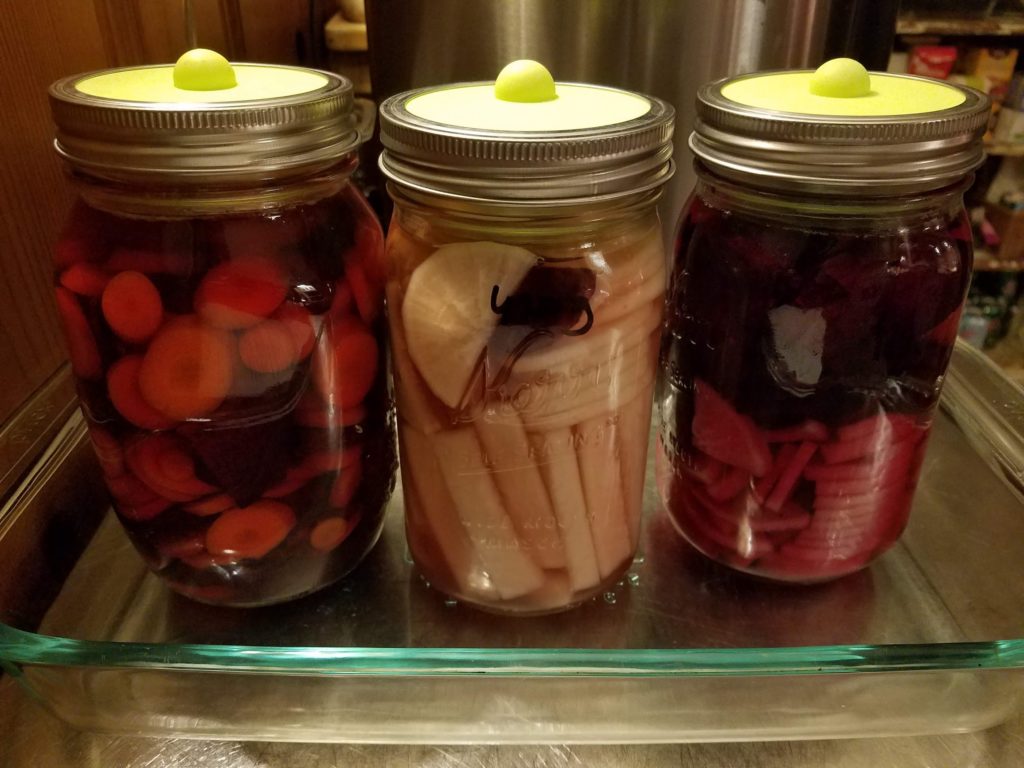
Tip: For spices, buy some re-usable tea bags. Cotton, nylon, whatever. This keeps your spices from floating to the top and getting moldy. Also much nicer when you fish out a pickle to chomp on. Remove the spice pack when you like the flavor balance.
2.3% salinity. 858g water + vedge, 20g seasalt.
After jarring everything up I got worried that the lactobacilli wouldn’t have enough sugar to work with in this higher salt solution with low-carb daikon. So I splashed in a teaspoon or so of sugary pomegranite italian soda. I seriously doubt any of that flavor will come through, I just did it for the cane sugar.
Started 1/20 1.7 saline. 838g water + vedge, 15g sea salt
1% saline. 1038g water + vedge, 10g sea salt.
Filed under: Uncategorized | Comments (1)
July 27, 2019
Eggs! Eggs! Eggs! Completely obsessed. Here are three clay ostrich eggs I made with the plaster mold from our last craft day:
Obviously, the next step is to bring together crafting and pickling!
I started with this recipe. It’s salt by volume (argh!) so I converted to metric and weight. 17g salt / 118 ml = 14% Dang that’s very salty! I don’t think lactobacilli can thrive in that, can they? Another recipe said 1T salt with 1c water, only 7% salinity. A third said 1T with 2c water! There doesn’t seem to be a standard amount.
Another mystery, all the recipes I found don’t have any sugar in them. Lactobacilli eat sugar, eggs have none, what do they eat to produce the acid that pickles the eggs?
Alrighty, I’m going to try my own recipe. Rather than add sugar, I’ll add sweet vegetables to provide food for the lactocritters. I have some leftover brine from a batch of beets, that’s going in too giving the brine a fermentation jump start and extra purple dying for the eggs. I’ll mix additional salt water at 3.5% saline, the lowest I found in recipes but higher than most vegetable ferments… this should still be salty enough to inhibit bad bacteria.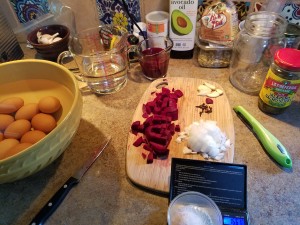
For the eggs, I put them in water, brought to a boil, turned it off and waited 7 minutes, then dunked in an ice bath before peeling. I’m shooting for softer yolks b/c I believe the acidic ferment will firm them up more and I don’t want them to come out dry.
Pack the jar starting with the garlic and cloves on the bottom. Add a couple eggs in and fill the spaces around them with beets, onions, and jalapeños. Continue this way up to about 2 inches from the top of the jar. I used one of those fatter mason jars to get more eggs in.
Pour in the beet brine. Pour in salt water up to the 2″ line. If using a pickling cup, fill just past the bottom of the cup. Screw on your airlock lid and set on the counter.
In the end I used 150ml of the beet brine and 100ml of the fresh saline.
((150 * .02) + (100 * .035)) / 250 = about 2.5% saline.
That’s lower salinity than recipes on the internet but I’m not worried. This should be enough to avoid spoilage and lactobacilli are really good at eating other microorganisms.
The recipes all say 3 days which again confuses me… vegetable brine pickles take a week to complete primary fermentation, lowering the pH to pickling strength. How could there be enough acid in the jar after only 3 days? I’m going to measure with a pH meter every day.
If push comes to shove, I’ll drain some of the brine and add vinegar to finish pickling the eggs in the refrigerator.
UPDATE Wednesday 7/31/2019
These came out great! I tasted an egg in Tuesday and it was tasty so I put them in the fridge. Surprisingly, the brine is tart so the lactocritters had enough time to do their job. Next time I think I’ll add a few cloves and use more jalepenos.
Filed under: Uncategorized | Comments (0)
July 7, 2019
Way back in 2015 Kathy and Allan gave me a couple ostrich eggs. I’ve been semi-obsessed with them but slow to scratch my creative itch. A couple years ago I made a latex mold… and forgot to add keys so the two halves fit together properly! Har har.
Today K&A had us over for craft day so it was a perfect chance to play with eggs again. This time I made a plaster mold in three parts. I plan to use it to make slip cast clay eggs. The mold didn’t come out perfect, I forgot to use a releasing agent (soap) for the first section. Lost some texture and there are some tears in the surface b/c I was rushing. No worries, I can always make another mold if I decide I need perfection.
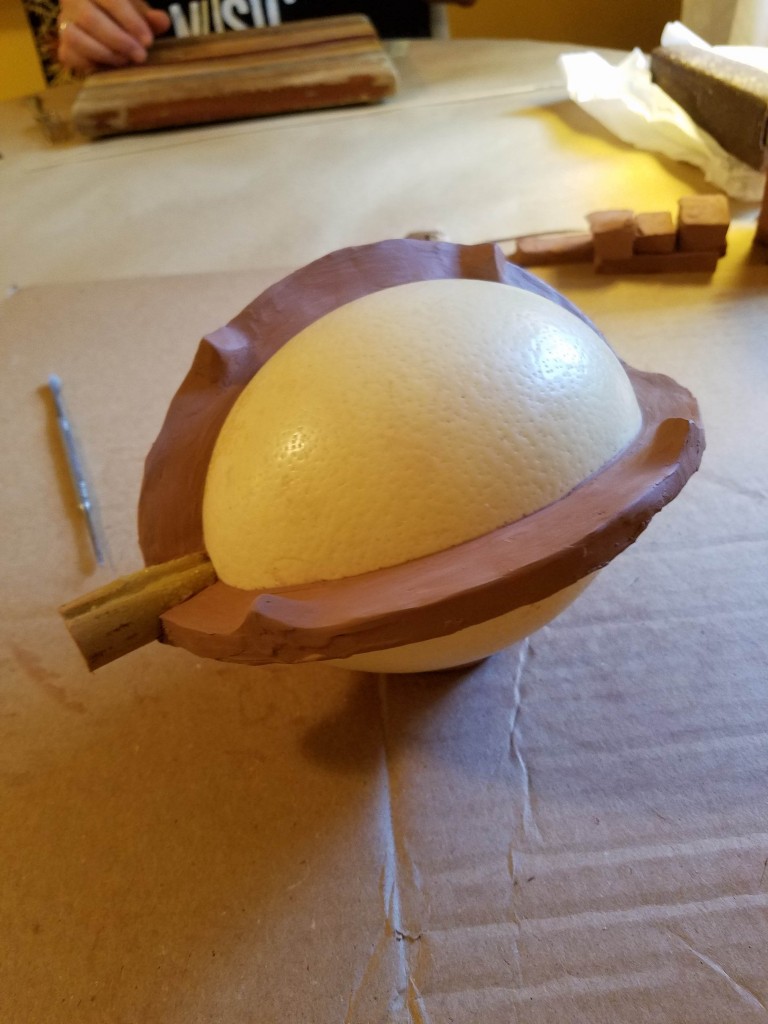
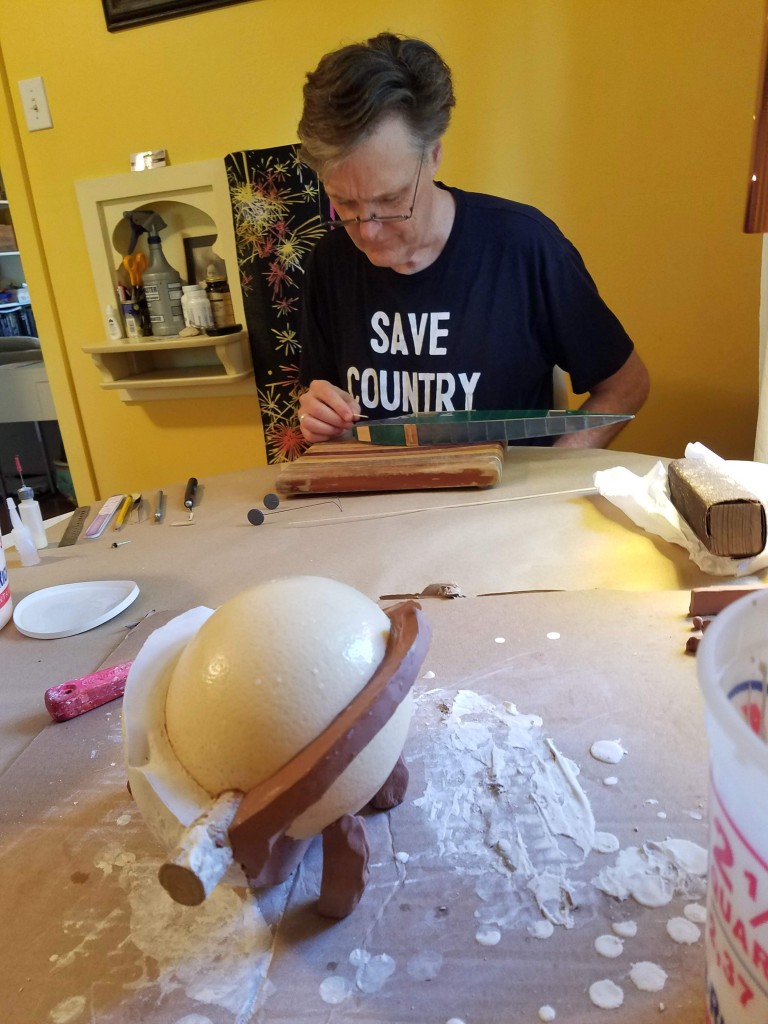
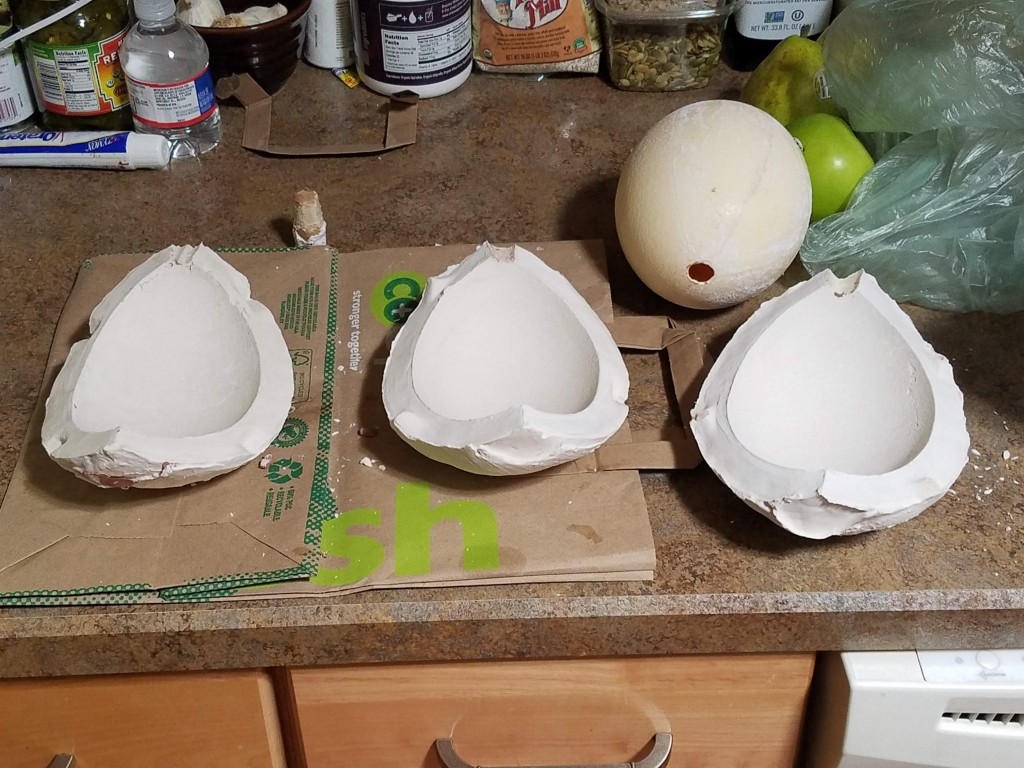
Filed under: Uncategorized | Comments (0)